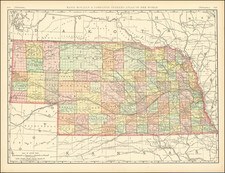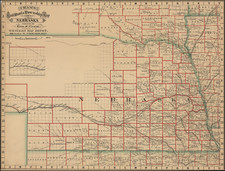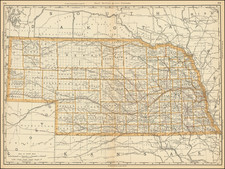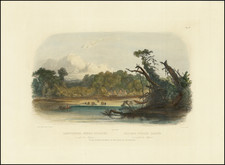One of the Earliest Obtainable Separate Maps of Omaha, Nebraska
With Manuscript Addition Showing the Future Omaha Belt Railway
Rare separately issued promotional map of Omaha, Nebraska, "Compiled and Drawn by Adin Mann, Civil Engineer."
Oriented with east at the top, the map illustrates Omaha immediately after the opening of the Union Stockyards. The map has been hand-annotated to show the future line of the Omaha Belt Railway and its connection to the Missouri Pacific Railroad.
One of the earliest obtainable printed maps of Omaha, dated January 19, 1885, just 6 months after the Omaha Union Stockyards opened in August 1884 with a shipment of longhorn cattle from Wyoming as the first tenants. By early 1885, a slaughterhouse began operating in the shadow of the yards. Almost overnight, Omaha went from a sleepy frontier town to a hub of agriculture and commerce, thanks to its upstart namesake: South Omaha.
The map offers a fine early plan of Omaha west of the Missouri River, including South Omaha and the many small subdivisions and additions, including the names of some of the landowners in areas not yet subdivided. The lines of the Union Pacific Railroad are shown, along its Smelting Works, Shops and other infrastructure, along with the line and grounds of the Burlington & Missouri River Railroad.
Shows tracts, block numbers, townships, sections, quarter sections, railroads, roads, owners of large parcels, etc.
The map is quite similar to the state of the map published by Everts & Kirk in The official state atlas of Nebraska. Compiled from government surveys, county records and personal investigations. Philadelphia, Everts & Kirk, 1885. However, it lacks page numbers.
Omaha Belt Railway
The Omaha Belt Line was a 15-mile long railroad encircling Omaha, Nebraska, starting in 1885. Initially operated by the Missouri Pacific Railroad, the Belt Line carried passengers and cargo, with its first segment running from the Sarpy County line into Downtown Omaha.
The Omaha Belt Line's inception is linked to the Union Pacific Railroad, whose officers first registered it as a "pet project" in 1883. In 1885, railroad tycoon Jay Gould saw the strategic potential of the Belt Line for his Missouri Pacific Railroad, providing direct access to Downtown Omaha. Previously, the Missouri Pacific Railroad reached Omaha via Union Pacific-owned tracks, connecting at Portal, Nebraska, near Papillion. Gould, leveraging his influence, orchestrated the takeover of the Omaha Belt Railway from the Union Pacific, enlisting local officials on the board to ensure local support. The line was completed using materials from both Union Pacific and Missouri Pacific, leading to a dispute later brought before the US Railway Commission, though it was eventually dropped.
Omaha
Omaha, located on the western bank of the Missouri River, has a rich history that predates its establishment as a city. The area was originally inhabited by various Native American tribes, including the Otoe, Omaha, Ponca, and Pawnee. The Lewis and Clark Expedition of 1804-1806 passed through the region, noting its strategic location and potential for settlement.
The foundation of Omaha began with the passage of the Kansas-Nebraska Act in 1854, which opened the territory for settlement. William D. Brown is often credited with establishing the town after recognizing the potential of the land he saw while operating a ferry service across the Missouri River. Omaha City was officially founded on July 4, 1854, and soon became the territorial capital of Nebraska.
Omaha's early years were marked by rapid growth and development. The city's advantageous position along the river facilitated its emergence as a key transportation and trading hub. The arrival of the Union Pacific Railroad in 1867, as part of the transcontinental railroad project, significantly boosted Omaha's economy and population, solidifying its status as a major gateway to the West.
The 1870s and 1880s saw Omaha expand rapidly, driven by the livestock and meatpacking industries. The establishment of the Union Stockyards in 1884 transformed the city into a major center for meat processing, attracting workers and businesses. The population grew steadily, and by 1890, Omaha had over 140,000 residents.









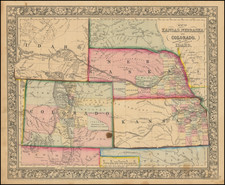
![Military Map of Nebraska and Dakota by Lieut. G.K. Warren . . . [Second state]](https://storage.googleapis.com/raremaps/img/small/95390.jpg)
